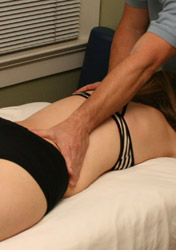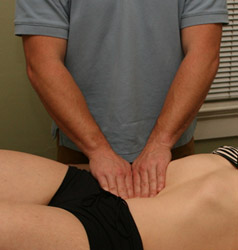Myofascial Release Therapy
for Back Pain
 Myofascial Release Therapy (MFR) can help back pain by releasing fascia compressing discs, by releasing opposing muscles such as the psoas, by improving overall posture, and by directly releasing back muscles, thereby stopping the pain-spasm-ischemia cycle. Myofascial Release Therapy (MFR) can help back pain by releasing fascia compressing discs, by releasing opposing muscles such as the psoas, by improving overall posture, and by directly releasing back muscles, thereby stopping the pain-spasm-ischemia cycle.
Through easy, deep expansion of a tight area using warm hands directly on the client's skin, the MFR therapist can help release fascia along the spinal cord and around the lower back. This work actually changes the make up of the fascia. The piezo-electric effect reydrates the tissue. It's like returning dried glue back into gel. This work of opening spinal and surrounding fascial tissue can help the work of your Chiropractor or Physical Therapist. As the fascia release, vertebrae are free to move back into proper alignment.

Like a tent with one side's lines too tight, the psoas pulling on your lumbar vertebrae could be part of your back problem. One of the major tenets of MFR is that the symptom is often not the cause of your pain. The psoas is a deep, core muscle which runs from your anterior (stomach side) spine (L1-5) to your femur (thigh bone). If this muscle remains tight for long periods (e.g. sitting in a chair all day), the fasica within the muscle can shorten. MFR combined with special myofascial stretching can help to release the psoas, allowing the posterior back muscles to work less. The psoas also controls the curvature of the lower spine. Thus, releasing the psoas allows the lumbar vertebrae to stack properly.
|